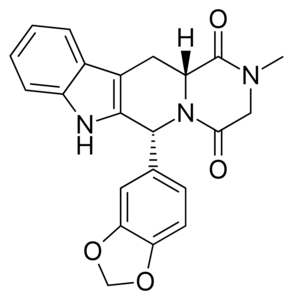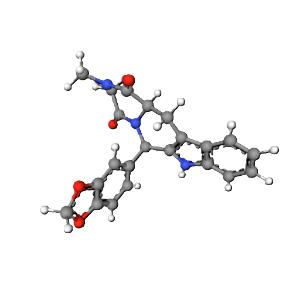
Tadalafil is a phosphodiesterase type 5 (PDE5) inhibitor widely used to treat erectile dysfunction (ED), benign prostatic hyperplasia (BPH), and pulmonary arterial hypertension (PAH). Its long duration of action, favorable safety profile, and effectiveness make it a cornerstone treatment for these conditions. This guide explores the structure, properties, pharmacology, uses, and safety of Tadalafil.
1. Structure of Tadalafil
The molecular structure of Tadalafil underpins its ability to inhibit PDE5 and enhance smooth muscle relaxation.
2D Structure
The 2D structure of Tadalafil reveals a pyrimidinedione core attached to a piperidine ring and a benzodioxole moiety. These structural elements enhance its specificity and binding affinity for PDE5 enzymes.

3D Structure
The 3D conformation of Tadalafil highlights its ability to fit into the PDE5 enzyme’s active site, effectively blocking its activity and increasing cyclic guanosine monophosphate (cGMP) levels.

2. Names and Identifiers
Tadalafil is recognized under various names and identifiers in medical and pharmacological databases.
Explore a leading manufacturer of APIs.
With over 10 years of expertise, we ensure GMP compliance and provide reliable, high-quality solutions.
- IUPAC Name:
(6R,12aR)-6-(1,3-benzodioxol-5-yl)-2-methyl-2,3,6,7,12,12a-hexahydro-1H-pyrazino[1′,2′:1,6]pyrido[3,4-b]indole-1,4-dione - Molecular Formula:
C22H19N3O4 - Molecular Weight:
389.41 g/mol - CAS Registry Number:
171596-29-5 - Synonyms:
Cialis, Adcirca
3. Chemical and Physical Properties
The chemical and physical properties of Tadalafil contribute to its role as a PDE5 inhibitor.
| Property | Details |
|---|---|
| Appearance | White to off-white crystalline powder |
| Melting Point | ~301°C |
| Solubility | Practically insoluble in water; soluble in ethanol and methanol |
| LogP (Partition Coefficient) | ~2.1 |
| Chemical Class | Phosphodiesterase Inhibitor |
4. Drug and Medication Information
Tadalafil is widely used to manage conditions related to smooth muscle relaxation and vascular function.
Formulations
- Tablets:
- Available in strengths of 2.5 mg, 5 mg, 10 mg, and 20 mg.
Mechanism of Action
Tadalafil works by:
- Inhibiting PDE5 Enzyme: Prevents the breakdown of cGMP, a molecule that promotes smooth muscle relaxation.
- Enhancing Vasodilation: Increases blood flow to specific tissues, such as the penis, lungs, and prostate.
Dosage and Administration
- Erectile Dysfunction (ED): 10 mg taken prior to anticipated sexual activity; adjusted based on response. For daily use, 2.5 mg once daily.
- Benign Prostatic Hyperplasia (BPH): 5 mg once daily.
- Pulmonary Arterial Hypertension (PAH): 40 mg once daily.
Follow your doctor’s instructions for the correct dosage.
5. Pharmacology and Biochemistry
Tadalafil’s pharmacology underscores its ability to improve vascular and smooth muscle function.
Pharmacokinetics
- Absorption:
Rapidly absorbed after oral administration with a bioavailability of ~80%. - Onset of Action:
Effects begin within 30 minutes, with a half-life of ~17.5 hours, allowing prolonged activity. - Metabolism:
Metabolized in the liver by cytochrome P450 enzymes (CYP3A4). - Excretion:
Primarily excreted in feces and a small amount in urine.
Pharmacodynamics
Tadalafil enhances the effects of nitric oxide (NO) by inhibiting PDE5, which increases cGMP levels. Elevated cGMP relaxes smooth muscle and improves blood flow to target tissues.
6. Uses and Side Effects
Primary Uses
- Erectile Dysfunction (ED):
Improves erectile function by increasing blood flow to the penis. - Benign Prostatic Hyperplasia (BPH):
Reduces symptoms like difficulty urinating and frequent urination. - Pulmonary Arterial Hypertension (PAH):
Lowers pulmonary blood pressure and improves exercise capacity.
Benefits
- Long duration of action (up to 36 hours).
- Flexible dosing options for daily or on-demand use.
- Effective in multiple vascular-related conditions.
Side Effects
Common side effects include:
- Headache.
- Flushing.
- Back or muscle pain.
- Indigestion.
Rare but serious side effects:
- Vision or hearing loss.
- Prolonged or painful erection (priapism).
- Severe allergic reactions.
Consult your doctor if side effects persist or worsen.
7. Safety and Hazards
Safety Profile
Tadalafil is generally safe when used as prescribed. However:
- Contraindications: Not suitable for patients taking nitrates or with severe cardiovascular conditions.
- Pregnancy and Breastfeeding: Not indicated for use in women; consult your doctor for alternatives.
Chemical Safety

Handling Precautions
- Store at room temperature, away from moisture and heat.
- Keep out of reach of children.
Environmental Impact
Tadalafil is biodegradable and poses minimal environmental risks when disposed of properly.
Chemignition Laboratory is a globally trusted manufacturer and exporter of Tadalafil Active Pharmaceutical Ingredients (API).
We specialize in APIs and provide complete documentation support including,
- GMP Certificate
- COA
- MSDS
- Stability Data
- Impurity Profile
- ISO 9001 Certificate
Customized packaging and cold chain logistics ensure safe delivery of sensitive APIs worldwide.
We proudly serve pharmaceutical companies across the USA, Europe, Asia, and more.
Partner with Chemignition Laboratory for consistent quality, regulatory compliance, and reliable global supply.
FAQs
IUPAC Name of Tadalafil?
(6R,12aR)-6-(1,3-benzodioxol-5-yl)-2-methyl-2,3,6,7,12,12a-hexahydro-1H-pyrazino[1′,2′:1,6]pyrido[3,4-b]indole-1,4-dione.
Molecular Formula of Tadalafil?
C22H19N3O4
Molecular Weight of Tadalafil?
389.41 g/mol
CAS Number of Tadalafil?
171596-29-5
What is Tadalafil used for?
Tadalafil is used to treat:
- Erectile Dysfunction (ED): Improves erectile function by increasing blood flow to the penis.
- Benign Prostatic Hyperplasia (BPH): Relieves symptoms like difficulty urinating and frequent urination.
- Pulmonary Arterial Hypertension (PAH): Lowers pulmonary blood pressure and improves exercise capacity.
How does Tadalafil work?
Tadalafil works by inhibiting the enzyme phosphodiesterase type 5 (PDE5). This increases the levels of cyclic guanosine monophosphate (cGMP), promoting smooth muscle relaxation and improving blood flow in specific tissues.
Who is the manufacturer of Tadalafil?
Chemignition laboratory is manufacturer of Tadalafil.
